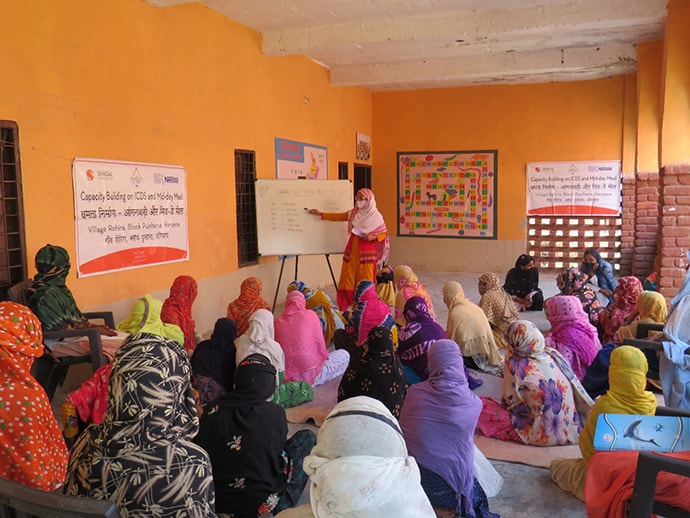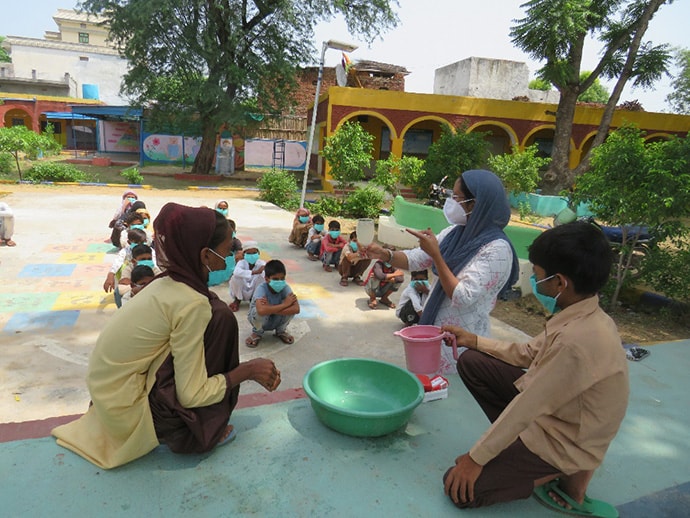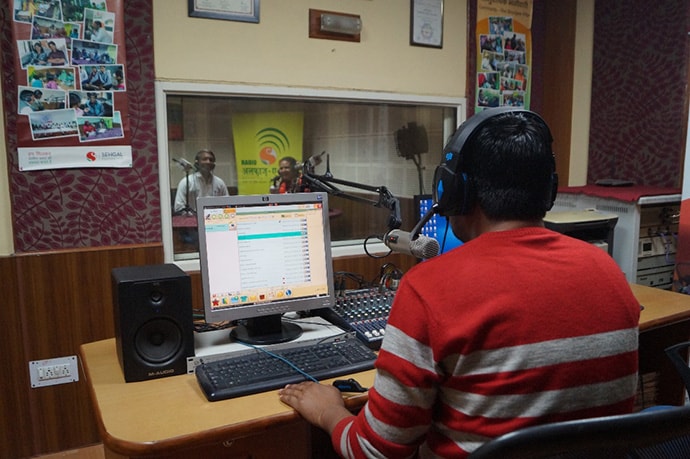By Arti M. Grover and Pooja O. Murada, S M Sehgal Foundation

Photo: S M Sehgal Foundation
Ensuring healthy lives and promoting well-being at all ages is essential to sustainable development. Sustainable Development Goal 3 (SDG 3) seeks to ensure health and well-being for all, at every stage of life. The goal addresses all major health priorities, including reproductive, maternal and child health; communicable, noncommunicable and environmental diseases; universal health coverage; and access to safe, effective, high quality, and affordable medicines and vaccines for all.
With the COVID-19 pandemic, this goal has become even more critical. According to the Department of Economic and Social Affairs, UN Secretariat, about 70 and 60 percent of the population of low and lower-middle income countries, respectively, comprises rural population and about 80 percent of people below poverty line live in rural areas. Therefore, the SDGs cannot be achieved without progress in rural development.
S M Sehgal Foundation (Sehgal Foundation), a rural development NGO in India, has been working in the rural communities with the vision to see every person leading a more secure, prosperous, and dignified life. To improve the quality of life of the rural communities in India, the foundation creates sustainable programs to address rural India’s most pressing needs through its programs on water, agriculture, local participation, Transform Lives one school at a time, and Outreach for Development. The foundation team’s focus on SDG 3 can be seen through the multifaceted approach it adopts to drive health and well-being in communities across eleven states in India where the foundation works.
Relief to Rehabilitation: Ensuring Good Health during Pandemic and Beyond
Sehgal Foundation’s support in response to COVID-19 focused on distribution of essential items such as soaps, sanitizers, masks, gloves, and thermal scanners to frontline workers and villagers, and food and nutrition kits to underserved communities.
Moving from relief to rehabilitation, the foundation activities and programs focused on building rural resilience with improved farm productivity (better agri technologies and practices), and increased water availability in villages (rainwater harvesting and groundwater recharge). Schools were made safer for children with handwashing stations, toilets, and drinking water facilities; and community awareness of relief materials made available by central and state governments increased. Even now, the foundation is sensitizing the communities toward the new normal and promoting vaccination coverage.
In several interventions villages, the foundation has revived the Integrated Child Development Services (ICDS) anganwadi centers to become fully functional to serve the target population—children aged 0-6 years, pregnant women, and lactating mothers. In addition, the team builds capacities of health sanitation and nutrition committees working in the villages for effective implementation of health and hygiene works.
Training women as Swasthya Sakhis (Friends for Health) spreads health awareness in villages on preventive and remedial health, timely vaccination of children, and menstrual hygiene. These groups after training are assisted with tools and methodologies, including participatory games, like Ludo and snakes and ladders on themes such as nutrition and menstrual hygiene to promote fun-learning and better retention among villagers.
Hand Hygiene Matters
A regular supply of water, sanitation, and hygiene (WASH) practices are key components in any basic health service system. The most critical aspects are access to safe drinking water, use of toilets, and hand hygiene. Correct and continuous practices of WASH lead to prevention of disease spread. Rural communities face health challenges due to lack of access to clean water, proper sanitation, and availability of soap and handwashing facilities.

Photo: S M Sehgal Foundation
To tackle these social, economic, and health-related challenges, the foundation through its programs spreads awareness about the importance of safe drinking water, use of toilets, and the benefits of washing hands thoroughly. Sensitization and awareness-building sessions are aimed at improving WASH behavior. The foundation’s simple, low-cost, and locally made technologies named JalKalp and MatiKalp also ensure availability of safe drinking water in rural households.
Clean and Safer Surroundings
Waterlogging and poor liquid waste management were longstanding issues plaguing inhabitants in rural areas. Lack of awareness on water management and the importance of sanitation and wastewater management practices results in people suffering from diseases such as diarrhea, malaria, and dengue.
When villagers attend sanitation-awareness sessions where the objective is to sensitize villagers to maintain good hygiene and sanitation practices in their daily lives, they learn about the importance of maintaining good personal hygiene and how to create cleaner surroundings for a healthy and disease-free life.
The foundation team conducts sanitation rallies, constructs soak pits and soak wells to prevent waterlogging and treat wastewater on the streets in villages so that villagers experience clean and safer surroundings.
Using Traditional Media for Health Communication
Choosing a right medium for outreach is integral part of building awareness on any issue. For rural areas, with limited access to media and low literacy levels, community media fills the information gap.

Photo: S M Sehgal Foundation
Community radio Alfaz-e-Mewat is started by Sehgal Foundation in the year 2012. It is a community-led radio station broadcasting for thirteen hours daily in district Nuh, Haryana. The radio has been presenting regular programs on health, building awareness on disease prevention and healthy eating habits. During the pandemic, its role to spread awareness on public health across the 225 reach villages was used to transmit information about vaccination from the district administration. Six to seven programs were dedicated to COVID-19 during the initial waves and awareness programs continue to be broadcast on maintaining COVID-19 appropriate behavior. Messages aired from the station have helped ease fear around the vaccines. Officials claim it has helped increase the number of villagers reaching the vaccination centers. The station’s programs together with experts have also addressed mental health issues across various stakeholder groups in the community.
Green Workplace Ensures Well-Being

Photo: S M Sehgal Foundation
Across the world, the building sector generates 38 percent of global CO2 emissions from buildings must fall 50 percent by 2030 if we are meet global net zero targets by 2050 (Source: UNEP)
Sehgal Foundation constructed its headquarters building in Gurugram, Haryana, according to the Platinum Standards LEED set by U.S. Green Building Council and the Indian Green Building Council. Sehgal Foundation’s building includes green features such as photo-voltaic solar panels on the rooftop, generating 35 kW of electricity; solar water heaters; shading devices; a rainwater harvesting storage tank of 800,000 litres; onsite recycling of grey and black water; groundwater recharging (zero runoff site); courtyards maximizing natural light and ventilation; recycled wood; various endangered plant species; use of in-situ bricks; maintenance-free exteriors; insulated walls; use of rapidly renewable rubber wood and bamboo; double-glazed glass, and a highly reflective roof finish, among others.
The building is not only environment friendly, but also provides a healthy and conducive workplace, leading to better health and productivity.
Conclusion
“I had no idea about balanced diet and nutrition. In our daily food pattern, we never focused on these aspects; but the interventions made us realize the importance of consuming nutritious food and safe water for a healthy life,” says Miskina, a housewife, one among thousands of beneficiaries who now have increased awareness levels to be able to lead healthier lives.
SDG 3 is both a contributor to and beneficiary of sustainable development, its linkages to all the other SDG targets is relational. Success or failure on one front may impact other outcomes as well. Complementing efforts by the governments, civil society, and other groups enable the achievement of these targets, one healthy life at a time.